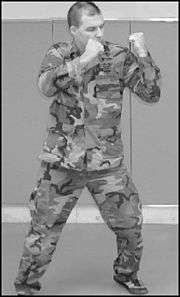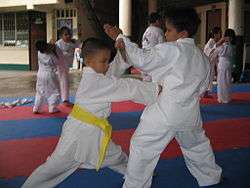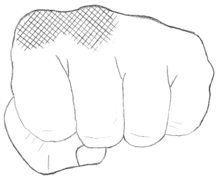Punch (combat)
It is used in most martial arts and combat sports, most notably boxing, where it is the only type of offensive technique allowed. In sports, hand wraps or other padding such as gloves may be used to protect athletes and practitioners from injuring themselves.[1][2] The use of punches varies between different martial arts and combat sports. Styles such as boxing, Suntukan or Russian fist fighting use punches alone, while others such as Kickboxing, Muay Thai, Lethwei or karate may use both punches and kicks. Others such as wrestling (excluding professional wrestling) and judo (punches and other striking techniques, atemi, are present in judo kata, but are forbidden in competitions) do not use punches at all. There are many types of punches and as a result, different styles encompass varying types of punching techniques.
| Punch | |
|---|---|
 A jab |
Basic types

This is not a comprehensive list of all punches, due to the large diversity of schools of practice whose techniques, employing arm, shoulder, hip and leg work, may invariably differ.
| Name | Description |
|---|---|
| Backfist | A backfist is performed by forming a fist and striking with the backside of the fist.[3] A spinning backfist is performed when the attacker swivels 360 degrees before landing the punch, adding extra momentum to the attack. The fighter will lunge and begin spinning toward the side of the opponent of which fist he or she will attack with. Simpler terms, go to the left, spin to the left and connect with the left fist and vice versa.[4] |
| Chambered Punch | A strike commonly performed in karate, kung fu, and tae kwon do, originating from a "chambered" position. |
| Cross or straight | A direct straight punch similar to the jab, except delivered with the rear hand. Power is generated through the rotation of the hips.[5] |
| Jab | The jab is a straight blow delivered (generally from a distance) with the arm above the lead foot ... The punch is quick and explosive. This punch must land from the very tips of the knuckles and not from a flat fist. " It is generally used for distraction, keeping distance, setting up, and defense.[6][7] |
| Leopard Blow (Long Fist) | By tucking the fingertips against the bottom knuckle of each finger, a long fist is formed. They offer decreased strength but increased reach. The striking surface is also narrower, which allows the fist to dig between ribs and other soft target areas. |
| Hammer Fist | A compacted fist is brought down upon the target, usually using the outside area of the fist.[8] |
| Haymaker | A punch in which the arm is whipped sideways from the shoulder joint with minimal elbow bend. The name is derived from the motion, which mimics the action of manually cutting hay by swinging a scythe. The haymaker is considered an imperfect/impure punch, as the angle of approach is unsupported by the remainder of the forearm. Since a haymaker's power is derived completely from weight transfer and momentum instead of muscle contraction, a long windup is required to generate sufficient force. Haymakers, in the form of shoulder punches, are frequently used from a mounted position in mixed martial arts as part of the "ground and pound" method, as the legs cannot be used to generate power. When thrown from standing, these punches leave the person vulnerable to a counter punch during the wind up, if blocked, or if the haymaker misses.[9] Haymaker is generally considered a street or barfighters punch, as it is the punch a person is most likely to use if they have not practiced martial arts and has little to no advantages over other punches such as the somewhat similar hook, making its use by martial artists rare. |
| Hook | A punch involving the use of turning to aim toward the side of the head or body. This punch must land from the very tips of the knuckles and not from a flat fist.[10] |
| Knuckle sandwich | An idiom for a punch in the mouth.[11] |
| Drop (boxing) (Overhand) | A semi-circular and vertical punch thrown with the rear hand. It is usually when the opponent is bobbing or slipping. The strategic utility of the drop relying on body weight can deliver a great deal of power. This punch must land from the very tips of the knuckles and not from a flat fist. |
| Shovel Hook | A close range punch that is halfway between a hook and an uppercut. Shovel hooks are most commonly used to strike the body at a 45 degree angle. For example, a liver shot can be done using a shovel hook. This punch must land from the very tips of the knuckles and not from a flat fist.[12] |
| Uppercut | The fist is raised vertically towards the target, usually the head or upper body. Since most guards are held with the arms in a vertical position, the uppercut can be used to avoid the opponent's attempts at blocking. This punch must land from the very tips of the knuckles and not from a flat fist. |
| Upset Punch | Starts with the fist in the chambered position, with the palm facing downwards, delivered to the abdomen or solar plexus. |
| Casting Punch | This is a punch used in Sambo and MMA that starts with a forward motion of the shoulders, which causes the bent arm to whip forward to the opponent. This punch can often cause the opponent to be put in a clinch if it misses at close range. |
| Superman Punch | A superman punch or diving punch is a technique used in Muay Thai, ITF-style Taekwon-Do, full contact karate and mixed martial arts fighting. The striker will lunge toward the opponent pushing off with the back foot punching with the opposite arm of the leg used to push off with although there may be variations in the name and technique, depending on the fighting style. The pose should resemble that of Superman flying through the air, hence the name. |
| Sucker punch | A punch that takes the enemy by surprise, possibly knocking them out or otherwise incapacitating them. Could be an unexpected blow to the stomach or a strike from behind that the victim did not see coming. |
Styles
Boxing
In boxing, punches are classified according to the motion and direction of the strike; contact is always made with the knuckles. There are four primary punches in boxing: the jab, cross, hook, and uppercut.

Karate

Punching techniques in karate are called tsuki or zuki. Contact is made with the first two knuckles (seiken).[13] If any other part of the hand is used to strike with, such as the back of the fist (uraken) or the bottom of the fist (tetsui), then the blow is classified as a strike (uchi).
Karate punches include the thrust punch oi-zuki made using the lead-hand, straight punch choku-zuki, reverse punch gyaku-zuki, made from the opposite (lead) hand, and many other variations.[14]
References
- "The Proper Way to Wrap Your Hands". Ringside.com. Archived from the original on 2007-04-26. Retrieved 2007-07-29.
- Ballard, Willie L. "Portable Hand Wrap" Mar 22. 1994. Retrieved on June 29, 2007.
- Oyama, Masutatsu (2004). Mas Oyama's Classic Karate. Translated by Tomoko Murakami. New York: London: Sterling; Chrysalis (distributor). pp. 16–17. ISBN 1-4027-1287-1.
- Carr, Tony. "IFA Kickboxing Library". International Fitness Association. Spinning Backfist. Archived from the original on 2016-06-29. Retrieved 2011-11-09.
- Scully, John. "Learn To Box". Saddo Boxing. Archived from the original on 10 January 2002. Retrieved 25 June 2012.
- "Jab Punch". Encyclopædia Britannica. Archived from the original on 13 October 2007. Retrieved 29 June 2007.
- "Jab punch". All-Karate.com. Retrieved 25 June 2012.
- Oyama, Masutatsu (2004). Mas Oyama's Classic Karate. Translated by Tomoko Murakami. New York: London: Sterling; Chrysalis (distributor). p. 26. ISBN 1-4027-1287-1.
- Mongold, Brian; The Wolf. "How to Throw a Punch". Eazycheezy.net. Retrieved 25 June 2012.
- "Hook Punch Technique". Physical-Arts.com. Retrieved 25 June 2012.
- "Knuckle sandwich". The Free Dictionary.
- "Shovel Hook". Boxing4Free.com. Retrieved 25 June 2012.
- Oyama, Masutatsu (2004). Mas Oyama's Classic Karate. Translated by Tomoko Murakami. New York: London: Sterling; Chrysalis (distributor). p. 13. ISBN 1-4027-1287-1.
- Funakoshi, Gichin (1994). Karate-dō Nyūmon: The Master Introductory Text. Translated by John Teramoto. Tokyo: Kodansha International. pp. 51–52, 64–65. ISBN 4-7700-1891-6.
External links and further reading
![]()
- "One punch-The Wing Chun Warrior's Attack Strategy". Kung Fu Magazine.
- "How to punch harder in a street fight"